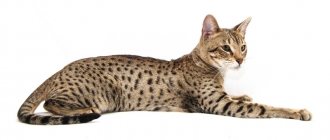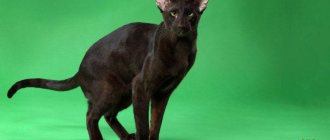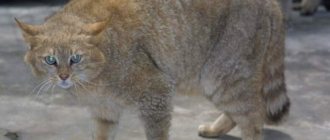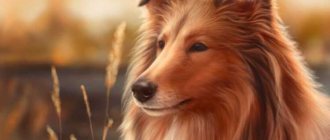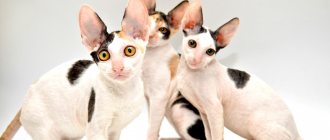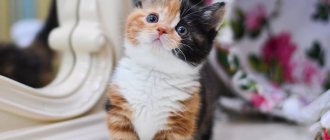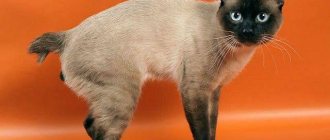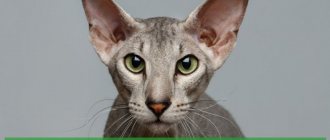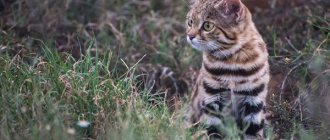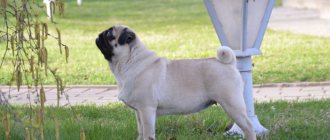Description of the Ragamuffin cat breed
Popularity 23rd among 87 cat breeds
Lifespan:
11-15 years
Height:
28-33 cm
Country of origin:
USA
Average price:
53-79 thousand rubles
Weight:
5-10 kg
Latest articles Cat health
Ataxia in cats: what is it, how does it manifest and is treated 01/23/2022 163 0 0
Cat health
Leukemia, or viral leukemia in cats 01/23/2022 148 0 0
Education and physical activity
Ragamuffins are intelligent cats and can be trained well. Fluffy representatives of the breed try to please their owners in everything and quickly remember the rules of behavior in the house. If desired, ragamuffins can even be taught basic commands and simple acrobatic tricks.
Despite their slightly phlegmatic temperament, Ragamuffins will not refuse to run after a ball or a laser pointer. To ensure that fluffy cats have the opportunity to maintain physical fitness, they are equipped with a special corner with multi-level areas and bought interactive toys.
Advantages and disadvantages
- Pros:
- peaceful and calm character;
- patience, allowing you to get along with children and other animals;
- good health;
- high intelligence, facilitating training and education;
- unlimited trust in a person and devotion.
- Minuses:
- intolerance of loneliness;
- lack of a sense of security and ability to defend oneself;
- undeveloped hunting instinct;
- heavy shedding;
- increased vulnerability to stress.
Health and life expectancy
The Ragamuffin has good health; most cats do not suffer from anything serious until they reach old age. But in rare cases, hereditary diseases occur:
- hypertrophic cardiomyopathy;
- polycystic kidney disease;
- various gastrointestinal dysfunctions;
- allergies.
Life expectancy - 12 years or more.
All that is required of the owners in terms of medical care for the pet is to take it to the veterinarian for annual medical examinations and vaccinations, regularly treat it for external and internal parasites, provide adequate nutrition and monitor its general well-being.
Responsible breeders try to test their breeding animals for known hereditary problems to prevent them from spreading through the breed.
History of the origin of the Ragamuffin breed
Ragamuffin is a consequence of a large-scale scandal between ragdoll breeders from the United States that occurred in 1994. The reason for the incident was the introduction of total control and mass bans on experimental matings. This decision was made by Ann Baker, an American breeder and founder of the Ragdoll breed.
In 1971, the enterprising lady created her own association IRCA (International Ragdoll Cat Association) and was the first to register the name “Ragdoll” as a trademark. For several decades, she managed to control the breed standard through strict restrictions for breeders interested in breeding the breed. The latter worked as a franchise with mandatory payment of license fees and remunerations in the amount of 10% of the cost of each kitten sold.
In 1975, some breeders left IRCA and organized their own amateur community RFCI. They set themselves the goal of achieving recognition of the breed from international felinological organizations.
In 1994, several more people left IRCA and chose a different path. They were eager to improve the genetic potential and health of animals. Unlike the first group, they were not too worried about the ban on using the word “ragdoll.”
The breeders named their pets “Ragamuffins” and within a short time updated their appearance and genotype by crossing with Persian, Himalayan and mongrel cats. In 2003, the offspring resulting from this experiment were recognized by the CFA.
INTERESTING!
The original name of the breed (ragamuffin) translates as “ragamuffin,” but American breeders affectionately call their pets sweetmuffins, that is, “sweet muffins.”
How the breed appeared
For those who are only indirectly familiar with the English language, the name of the breed may seem, at first glance, rather “sweet”. The well-known word “muffin” catches your eye, and images of fragrant buns or cupcakes with raisins immediately appear in your head. However, in reality everything is not so simple. After all, among the English, a ragamuffin is a ragamuffin and a tramp. For fluffy and charming purrs, this name seems unexpected. However, after studying the history of the origin of the breed, everything falls into place.
It all started with the fact that in 1963, Persian cat breeder Ann Baker, living in the town of Riverside (USA), drew attention to a flock of yard cats. They were regularly fed by a neighboring family. Among these purrs was Josephine, who gave birth to beautiful long-haired kittens with an affectionate character in each litter. And although the fathers of each group of animals were different, according to Ann Baker, the cats inherited their friendly disposition from their mother. This circumstance was connected with the fact that the cat was rescued and people were coming out after a car accident. The breeder decided to consolidate such interesting features and develop a new breed from the street cats born to Josephine.
It was decided to name the new breed Cherub, which means “Highest angelic rank” in the Christian religion. However, Mrs. Baker set very strict demands for the clubs:
- only the founder herself could choose representatives for breeding the breed;
- decisions regarding matings also remained with the breeder.
Such control was not to the liking of many who wanted to breed the breed. And in 1967, a group of breeders decided to independently develop “cherubs”. To emphasize independence from Ann Baker, the name was changed to "Ragdoll". The main focus was obtaining additional types of animal coat colors. However, the breeder did not ignore this process. And, having changed the original name “Cherub”, she patented “Ragdoll” as the official one. From then on, kittens could only be used under Mrs. Baker's breeding program.
Ragdoll - the founder of the Ragamuffin breed
20 years later, having gone through numerous courts and disputes with breeders, the founder of the breed decided to leave breeding work. In 1993, the International Ragdoll Cat Association almost succeeded in taking control of the breeding of these fluffy purrs into its own hands. However, at the last moment Mrs. Baker changed her mind. And she began to breed another breed, crossing ragdolls with outbred long-haired cats. As a result, a large female was born, distinguished by its beautiful colors and unlike other “cherubs”.
This state of affairs was not to the liking of the breeders. Because of this, since 1994, some breeders have continued to develop the Ragdoll breed. And other breeders focused on distributing new “cherubs,” which were given the name “Ragamuffin” in honor of their outbred street ancestors.
Thanks to the mixture of various cat bloods - Persian, Himalayan, Siamese, outbred yard - Ragamuffins have expanded the color palette of colors. Other characteristics of the breed have also changed - the size of the body has become larger, and the iris of the eyes has become brighter and more colorful.
What does a ragamuffin look like?
The photo with the Ragamuffin shows that this cat breed is almost no different from the Ragdoll. They are just as cute, fluffy and heavy. The average weight of girls is 5-7.5 kg, and the weight of boys is 5-10 kg.
Muzzle
The wedge-shaped head with soft and slightly convex contours is located on a short and strong neck. The latter's muscularity increases as they grow older. On the short, oval muzzle, voluminous whisker pads and plump cheeks are clearly visible.
Large and expressive eyes are set far apart. The standard allows any color of the iris, subject to its intensity. Even heterochromia is not prohibited.
IMPORTANT!
More stringent requirements apply to the eyes of cats with sepia and mink colors. For the former, they should be golden-green, and for the latter, golden-blue or turquoise.
The neat triangular ears are slightly tilted forward. At their tips there are sometimes small lynx tassels, and inside there is a moderate amount of hairs protruding outwards.
Body type
The ragamuffin's compact body is rectangular in shape. Despite this, it appears nicely round and soft thanks to the increased amount of belly fat. The fat layer that forms by the age of 2 is a feature of the breed that does not affect the health of the animal. But protruding ribs and spine are a serious cause for concern.
The cat's limbs are also heavy and strong. The hind legs are always longer than the front ones, and tufts of wool always appear between the toes.
The medium-thick tail is distinguished by its elegance and thinness closer to the tip. It is covered along its entire length with light, airy fur.
Coat and color
The smooth and silky coat is medium to long. It feels like a rabbit's. The undercoat and spine of the animal are almost identical in length and have an equally dense structure. The longest hair grows in a “collar” around the neck, visually increasing the actual size of the head.
The breed standard allows for any known colors, including white spots and two or three colors on the nose and paw pads. Despite this, the CFA still rejects the temperature-dependent color point.
REFERENCE!
The most expensive color of the ragamuffin is white.
Disqualifying faults
In addition to the color-point color, disqualifying defects include polydactylism, strabismus, various tail defects, short or curly hair. Such ragamuffins are not allowed to compete and are excluded from further breeding.
Colors
Ragamuffins are allowed in many colors: sepia, mink, and striped. But the most common are the following:
- Tabby: the main color is any light. Bright contrasting spots of different sizes are scattered over the base.
- Bi-color: 2 primary colors.
- Color point: the color is exactly like that of Siamese cats (includes all shades of brown).
The standard allows for a small amount of white patches on the chest, back and belly.
In the photo there are cats of the Ragamuffin breed of the main colors: Tabby, Bi-color, Color point
Ragamuffin cat character
The Ragamuffin breed is a decorative breed, so the cats are completely unsuited to living independently on the street. They do not have a developed hunting instinct or self-defense. If they get lost on a walk, they will never find their way home and will most likely die in some cat fight over territory.
In the absence of aggression in its direction, the “mustache” quickly finds a common language with other pets and becomes attached to them no less than to a person. Even short-term loneliness is difficult for him, so it is better to take your pet with you while on vacation. Changing a cat's location does not frighten him at all if his beloved owner is next to him.
There are no problems when communicating with children. Representatives of this breed have angelic patience and never let out their claws. Some of them even allow you to dress yourself up in dresses and ride in a stroller.
Fluffy heavyweights love to sit on the hands and laps of not only their owners, but also strangers. They have no fear of strangers due to their innate trust in everyone around them.
Despite all their phlegmatic nature, these cats cannot be called outright lazy. They may well play pranks and have a nightly “tygydyk” with climbing the curtains, but they will definitely stop their adventures if one of the household members is against it.
Interesting Facts
- Some cats of this breed have “lynx tassels” on their ears. This is not a requirement and is not a disadvantage. But the value of the kitten increases due to such natural “tuning”.
- The word “Ragdoll” (the name of our hero’s ancestors) can be translated as “rag doll.” Indeed, those cats are considered quite lazy, they can hang on their hands. However, a “doll” in the literal sense should rather be called a ragamuffin. He is exceptionally good-natured in his relationships with children, he allows himself to be wrapped up, put in a stroller, and will stay there until they let him go. A real living toy.
- This cat cannot stand loneliness so much that sometimes he considers a parrot, a ferret, a guinea pig to be a suitable company for himself - as long as there is a living creature. Moreover, we repeat, he is completely devoid of the instinct of hunting and aggression.
- Little Ragamuffins are born all white. Their fur acquires its true heritage color at the age of 3-4 months.
Raising a Ragamuffin
Discreet and intelligent ragamuffins quickly get used to the tray and scratching post, and also master simple acrobatic tricks quite well. When raising them, it is important not to go too far with punishments, as these furry creatures are very vulnerable. Too loud a voice or unreasonable punishment can put a pet into a state of depression, causing a decline in immunity due to stress.
Despite the vulnerability of the animal’s soul, its periodic pranks must be stopped. Behavior problems can be observed at an early age, when the baby is testing the boundaries of what is permitted and bursting with energy.
“ If the kitten is tearing the wallpaper or climbing the curtains, stop it with the command “No” or “No”, using a strict, but not rude intonation. After several repetitions, he will understand that such behavior is unacceptable.
Special attention should be paid to conquering high surfaces. Unlike most mousecatchers, representatives of this breed do not know how to land accurately. Because of this, they are often injured, so jumping outside the scratching post, where there are convenient ladders, should be strictly prohibited.
Character and behavior
Ragamuffins are some of the most loyal human companions. Complaisant, good-natured, absolutely calm and good-natured - these words fully characterize the representatives of the breed. Their favorite pastime is to lounge imposingly at full length on an ottoman or windowsill and doze serenely, occasionally looking around. They are absolutely domestic: once they get outside, they can’t figure out what to do or where to run. Ragamuffins do not know how to defend themselves; at most, they will try to hide somewhere. They are frightened by loud noises, street hubbub and traffic, so walking the streets is absolutely unnecessary.
The gullibility of ragamuffins is amazing: they easily go into the arms of strangers and do not mind lying next to a guest and taking a treat from his hands.
Cats treat children calmly and steadfastly withstand their fun: they will sit in a doll's stroller and wear a doll's hat. If the child begins to offend him, he retreats under the sofa or asks the owners for intercession.
Ragamuffin loves “dad” and “mom” reverently, and endures separation extremely painfully. Therefore, careerists and avid travelers should avoid this breed: the cat will be sad and sick if you are not around. But for lonely, elderly people, this breed is a real gift.
The ragamuffin is friends with other animals, be it a dog, or a cat, or a rodent, or even a bird. But once a cat appears in a family, it takes a long time to get used to them, so it’s better to get one first.
According to folk wisdom, what should happen if a cat washes itself?
Receive a letter Guests will come
Ragamuffins are also phlegmatic (by the way, females remain playful with age, unlike males), but they are also not averse to playing. Running around before a hearty breakfast, fighting with an imaginary enemy or a sunbeam on the walls, rustling with a plastic bag is a nice thing for them. They have nothing against a playmate, but they also know how to have fun on their own.
Sometimes these games lead to sad results: torn curtains, knocked over flower pots. And it is better to stop such self-indulgence immediately. Cats are extremely intelligent and know how to obey. But do it gently, without rudeness and, moreover, without assault. Ragamuffin will perceive spanking as a betrayal.
Ragamuffins are not jumpers, that's a fact. At the very least, they will get off the chair, but jumping from cabinets often ends in injury. Therefore, the owner should take this point into account.
An interesting feature: ragamuffin relaxes in human hands, literally melts, like ice cream in the sun. This feature, by the way, is also noted in ragdolls.
Another characteristic characteristic of cats is curiosity, which should keep you on your guard at all times. The lazy-looking Ragamuffin loves to taste homemade flowers, lick cosmetics, rummage through the trash can, and poke his nose into an open bag of washing powder. And they not only unwind the balls, but also try to eat them.
Finding a Ragamuffin kitten is not that easy. Popular nurseries that breed them are located in South Korea, the USA, Europe and Canada. In Russia, you can only find ragdoll nurseries, in which, quite possibly, ragamuffins are also bred. The second option is private breeders. But this is a minus pedigree. Kittens “for the soul” will cost about 70-80 thousand rubles, animals for exhibitions - from 100 and above. Males are valued lower than female cats.
Ragamuffin Breed Health
Thanks to the presence of the blood of “nobles,” Ragamuffins have strong immunity and practically no genetic pathologies. With proper care and the absence of chronic disorders, their life expectancy reaches 15 years.
Possible diseases
All the diseases diagnosed in Ragamuffin came from Persian cats. These include:
- Polycystic kidney disease
. It is transmitted from parents by inheriting a defective PKD1 gene, which is responsible for protein synthesis. Accompanied by the gradual proliferation of cystic neoplasms and impaired filtering function of the kidneys. There is no cure, but it can be slowed down by a good ten years.
- Hypertrophic cardiomyopathy
. Refers to genetic pathologies and is characterized by rapid heartbeat with periodic fainting. It is incurable, but with timely consultation with a veterinarian, long-term remission can be achieved.
Allergies, periodontal disease and obesity are much less common in animals. Unlike genetic pathologies, all these diseases can be successfully prevented.
IMPORTANT!
Predisposition to polycystic disease can be determined using a DNA test. If the result is positive, the male or female cat must be excluded from breeding.
Reproductive health and breeding
After receiving CFA recognition, only animals of a similar breed were allowed to breed. Experimental crosses with other varieties are a thing of the past and are prohibited.
Ragamuffins mature late. Their breeding work begins after reaching 3 years of age. Before the meeting, both partners must be vaccinated and treated against parasites.
IMPORTANT!
For cats that are too shy and do not react to the smell of heat, it is better to find an experienced partner in advance. Otherwise, mating will not take place.
Problems with pregnancy and childbirth usually do not arise. The number of kittens in a litter varies from 6 to 7. The fur coat of newborns is always white, and their eyes are bright blue.
If there are no plans to breed the breed, or polycystic disease or hypertrophic cardiomyopathy is detected, the animal is spayed or neutered. The operation is carried out immediately after reaching sexual maturity or as indicated by a veterinarian.
Appearance
The American standard uses the word sweetness to describe ragamuffin in general. The appearance of these cats should evoke affection and be associated with health. Ragamuffins are quite large with well-developed muscles and a noticeable layer of subcutaneous fat, especially in the abdominal area. Cats weigh 4-6 kg, females - 7-10 kg.
The skull is wide. The muzzle is shaped like a wide wedge. The cheeks are outstanding. The ears are medium in size with rounded tips. Some individuals have tufts on their ears. The eyes are slanted, almond-shaped, often golden-green and bright green, but there are blue and aquamarine shades. Eye color should be bright and rich.
Ragamuffins look impressive. They have a fairly large body with well-developed muscles. The paws are large, with hair between the toes, the hind legs are slightly longer than the front ones. The tail is fluffy and long, tapering towards the end.
Ragamuffins differ from ragdolls mainly in their many different colors.
Ragamuffins have a medium-length coat with a silky texture and are generally not prone to matting. It is very pleasant to the touch, and should “flow” in appearance. The coat is slightly longer on the neck and on the outside of the head, forming a beautiful collar. Colors can be any except point (Siamese). The standard allows all patterns and colors, even with the presence of inclusions on the back, paws, and chest. It does not matter whether the markings or patterns are symmetrical. Paw pads and nose can also be of any color or combination thereof, they may even differ from the main color.
Features of feeding and diet
Ragamuffins love to eat big meals, so it's important to prevent them from becoming dangerously overweight. To do this, you need to calculate the safe daily caloric intake and create the correct feeding schedule.
At the owner's request, the diet can be either natural or dry. Each of them has its pros and cons, which you need to familiarize yourself with before making a final decision.
Natural nutrition
“Naturalka” is good for its ability to control ingredients when preparing dishes and its pleasant taste. Animals get used to regular food much faster than to dry food. There are no problems with the diet menu in case of illness. Despite this rosy picture, a natural diet has many disadvantages:
- loss of time as a result of daily preparation of fresh food;
- the impossibility of independently compiling a balanced menu with sufficient amounts of fats, proteins and carbohydrates;
- high probability of developing vitamin deficiency due to a lack of some vitamins and minerals.
When feeding naturally, vitamin and mineral complexes approved by a veterinarian must be added to the food. Independent selection in such a situation is unacceptable and can result in a surplus of nutrients.
Long-haired giants are very clean. During licking, a large amount of hair gets into their stomach, sticking together into bezoars (wool balls). To remove them, the animal needs to be given fresh herbs or special malt pastes.
Ready-made feed
This option is preferable. Representatives of the breed are prone to weight gain, and in stores you can easily find ready-made food for animals with slow metabolism. Unlike regular food, they contain only healthy ingredients and do not require added vitamins.
The only disadvantage of ready-made feed is the high price. The difference is most noticeable with a mixed diet, when wet pieces of spider meat and canned pates are added to the cat’s “crackers.”
The last 2 products not only cost more than the first, but also run out much faster. Despite this, veterinarians recommend this type of feeding as a preventive measure for dental diseases. Hard kibble protects teeth from tartar formation, and soft food reduces stress on the gums.
If you decide to choose ready-made food, take care of the animal’s drinking regime. Lack of fluid in the body can lead to the formation of urinary stones, so make sure your pet drinks his quota. This can be easily checked using a measuring cup.
Nutrition
It is better to use professional balanced food for long-haired cats. If you give natural food, be sure to add vitamins and minerals. Don’t forget about a special paste that “breaks up” hairballs in the stomach.
Animals of this breed are predisposed to gaining weight, even becoming obese, so it is important to control the quantity and quality of food. Eliminate from your diet everything fatty, floury, sweet, and especially spicy. Don't give him food from your table at all. Human food is harmful to cats.
It is better to cook him separately or give him some raw foods. For example, it is better to give lean and raw meat - chicken breast, turkey, and boiled fish. Include fermented milk products, eggs and green grass in your diet. Give foods that can cause allergies with caution. It is a good idea to add calcium to your food to strengthen your bones. And don’t forget to change the water on time.
Care and maintenance
Ragamuffins should absolutely not be allowed outside the apartment without supervision. Unlike the Norwegian Forest Dog and the Bengal, they do not need walks and can easily spend their entire lives without leaving their house or apartment.
Grooming
Despite the luxurious fur, caring for mustachioed giants is quite simple. Their coat is not prone to matting and practically does not shed. To maintain a neat appearance and remove dead hair, it is enough to brush your pet’s hair just once a week.
Daily brushing is only relevant during shedding. In kittens it lasts about a year, starting at 5 months. At a later age, molting occurs in autumn and the period from February to April. More frequent renewal of the fur coat is possible if the room temperature is too high.
For long-haired breeds, long-toothed combs are suitable. They glide well through the coat and help detangle hairs. After the procedure, the fallen hairs are removed either with a special napkin or with a damp hand.
Hygiene
All representatives of the breed are bathed when dirty with a special shampoo and conditioner for long-haired cats, but not more than once every 4-6 months. Washing outside the schedule is possible before a cat show, after repairs, or under other circumstances associated with a large amount of dust and dirt.
The most unpleasant procedure is brushing your teeth. Few animals perceive it adequately, so as an alternative, you can give your pet solid treats in the form of sticks and sausages. They eliminate unpleasant odors and remove plaque that accumulates after eating. Despite the convenience, it is important to understand that advanced cases can only be treated with ultrasonic cleaning under sedation.
If periodically brushing your teeth on your own doesn’t scare you, purchase any veterinary toothpaste and a special toothbrush designed for animals. To maintain cleanliness of the oral cavity, the procedure will have to be carried out 1-2 times a month for 3 minutes.
The pet's eyes are cleaned of plaque every day, and wax is removed from the ears once a week. In both cases, use regular cotton pads moistened with warm water. Special lotions that can be purchased at a pet store or veterinary pharmacy are also suitable for cleaning ears.
Diseases and defects of the breed
The immunity of cats is quite strong, because in their pedigree there were outbred street individuals. They made the breed stronger and more resistant to infections. So far, no disease associated with genetics has been identified.
Ragamuffins can get sick:
- allergies;
- cardiomyopathy;
- gastrointestinal disorders;
- polycystic kidney disease;
- periodontal disease;
- obesity.
Most of these predispositions can be corrected through proper and balanced nutrition and regular teeth brushing. Attention should be paid to vitamin complexes and supplements, as well as anti-parasitic prevention.
Timely vaccination of the animal will help to avoid a large number of problems in the future, especially with regard to viral diseases. If you take proper care of your ragamuffin and feed it correctly, it will be a loyal friend for quite a long time - up to 16 years.
It is necessary to take your pet to the veterinarian
Ragamuffin breeding
Females and male cats that have reached the age of three years are allowed to breed. Animals must be absolutely healthy, including those without internal parasites. All vaccinations must be included in the animal's passport. Male and female cats are listed as the same breed because interbreed matings are not allowed for Ragamuffins.
Due to their nature, Ragamuffins are not aggressive and are sociable. Cats, even sensing the cat's heat, behave very courteously and even shyly, so the animals may need a lot of time to get to know and get used to each other. Therefore, the Ragamuffin cat will have to be brought to visit the cat several times until the animals communicate.
Tips for choosing a kitten
The final color of “cherubs” is formed only by 4 months, so it is not advisable to get acquainted with kittens before this period. First of all, you need to check the documents of the nursery. He must be licensed by ACFA and CFA. It is equally important to evaluate the living conditions of the animals. If there is a lot of dirt around, contact another breeder.
When meeting a kitten directly, use the following recommendations:
- Make sure there are no signs indicating the presence of illness. Watery eyes, unpleasant odor from the fur or from the mouth, constant scabies, dirt under the tail and other alarming symptoms require mandatory isolation. It is not prohibited to get sick in the nursery, but to avoid infection, sick animals must be kept in a separate room.
- Study the length of the tail. Most kittens have a short length, but not cherubs. The impressive length of the tail relative to the body is observed already in early childhood and is clearly visible visually.
- Check the brightness and saturation of the iris. The higher they are, the better. It is also possible for the eyes to remain blue for up to 2 months, but most often the color changes within 5 weeks after birth.
- Try to communicate. A purebred kitten should not show cowardice or aggression. Curiosity and slight timidity are encouraged.
- Take the baby in your arms. The right Ragamuffin will immediately melt into a hug and hang like a rag doll, just like a Ragdoll. Remember that a purebred kitten should not struggle or show other signs of excessive activity.
Feel free to ask to meet the babies' parents and also check their breeding documents. Thanks to this, you will be able to evaluate the appearance of animals, the adequacy of their behavior, pedigree and the presence of diseases confirmed by a doctor.
How to choose a kitten
First of all, you need to pay attention to the eye color of the little Ragamuffin. The richer and brighter the shade of the iris, the better. Purebred kittens have a strong rectangular chest, a long tail and powerful hind legs. The pet must be active, playful, and not afraid of people. You should be wary if he is timid and does not make contact. The nose and eyes should be free of discharge, dry and clean.
How much does a ragamuffin cat cost?
The majority of nurseries are located in the USA. Single offers from breeders who have received official breeding permission can also be found in Canada, England, Austria, Bulgaria, the Netherlands and South Korea.
In Russia, they know even less about the breed than about the Ragdoll. The same applies to the CIS countries, so you can only buy a purebred pet abroad.
The average price for ragamuffin in rubles is 53-79 thousand rubles. The problem is that it does not include the cost of transporting the animal and the commission to the reseller.
Do you like the article? 0
Price
Based on the breed's birthplace, it is clear that the best kennels and breeders are in America. There are certified manufacturers in other countries - Canada, Bulgaria, Great Britain, Holland, South Korea, Austria. There is not one in Russia and post-Soviet countries. Although, probably, Ragamuffins can be bred in ragdoll nurseries.
There are many of them in Russia, and there are also in Ukraine. The price of a Ragamuffin cat and availability for sale must be negotiated individually. The cost of a kitten will depend on many factors: the sex of the animal, its pedigree, the presence of other conditions or circumstances - illnesses, habits, features. The average cost can be approximately 900-1000 dollars. If the breed is of a higher class, the cost will be more expensive.
Sterilization and castration
Ragamuffins that are not of breeding value are recommended to be sterilized. The operation is carried out in a veterinary clinic after the furry cat is 8-10 months old. This simple procedure will help prevent behavioral problems and maintain the health of the genitourinary system.
